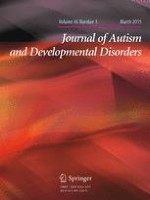01-03-2015 | Original Paper
Resting-State Alpha in Autism Spectrum Disorder and Alpha Associations with Thalamic Volume
Gepubliceerd in: Journal of Autism and Developmental Disorders | Uitgave 3/2015
Log in om toegang te krijgenAbstract
Alpha circuits (8–12 Hz), necessary for basic and complex brain processes, are abnormal in autism spectrum disorder (ASD). The present study obtained estimates of resting-state (RS) alpha activity in children with ASD and examined associations between alpha activity, age, and clinical symptoms. Given that the thalamus modulates cortical RS alpha rhythms, associations between thalamic structure and alpha activity were examined. RS magnetoencephalography was obtained from 47 typically-developing children (TDC) and 41 children with ASD. RS alpha activity was measured using distributed source localization. Left and right thalamic volume measurements were also obtained. In both groups, the strongest alpha activity was observed in Calcarine Sulcus regions. In Calcarine regions, only TDC showed the expected association between age and alpha peak frequency. ASD had more alpha activity than TDC in regions bordering the Central Sulcus as well as parietal association cortices. In ASD, whereas greater left Central Sulcus relative alpha activity was associated with higher Social Responsiveness Scale (SRS) scores, greater Calcarine region relative alpha activity was associated with lower SRS scores. Although thalamic volume group differences were not observed, relationships between thalamic volume and Calcarine alpha power were unique to TDC. The present study also identified a failure to shift peak alpha frequency as a function of age in primary alpha-generating areas in children with ASD. Findings suggested that increased RS alpha activity in primary motor and somatosensory as well as parietal multimodal areas—with increased alpha thought to reflect greater inhibition—might impair the ability to identify or interpret social cues. Finally, to our knowledge, this is the first study to report associations between thalamic volume and alpha power, an association observed only in TDC. The lack of thalamic and alpha associations in ASD suggests thalamic contributions to RS alpha abnormalities in ASD.
